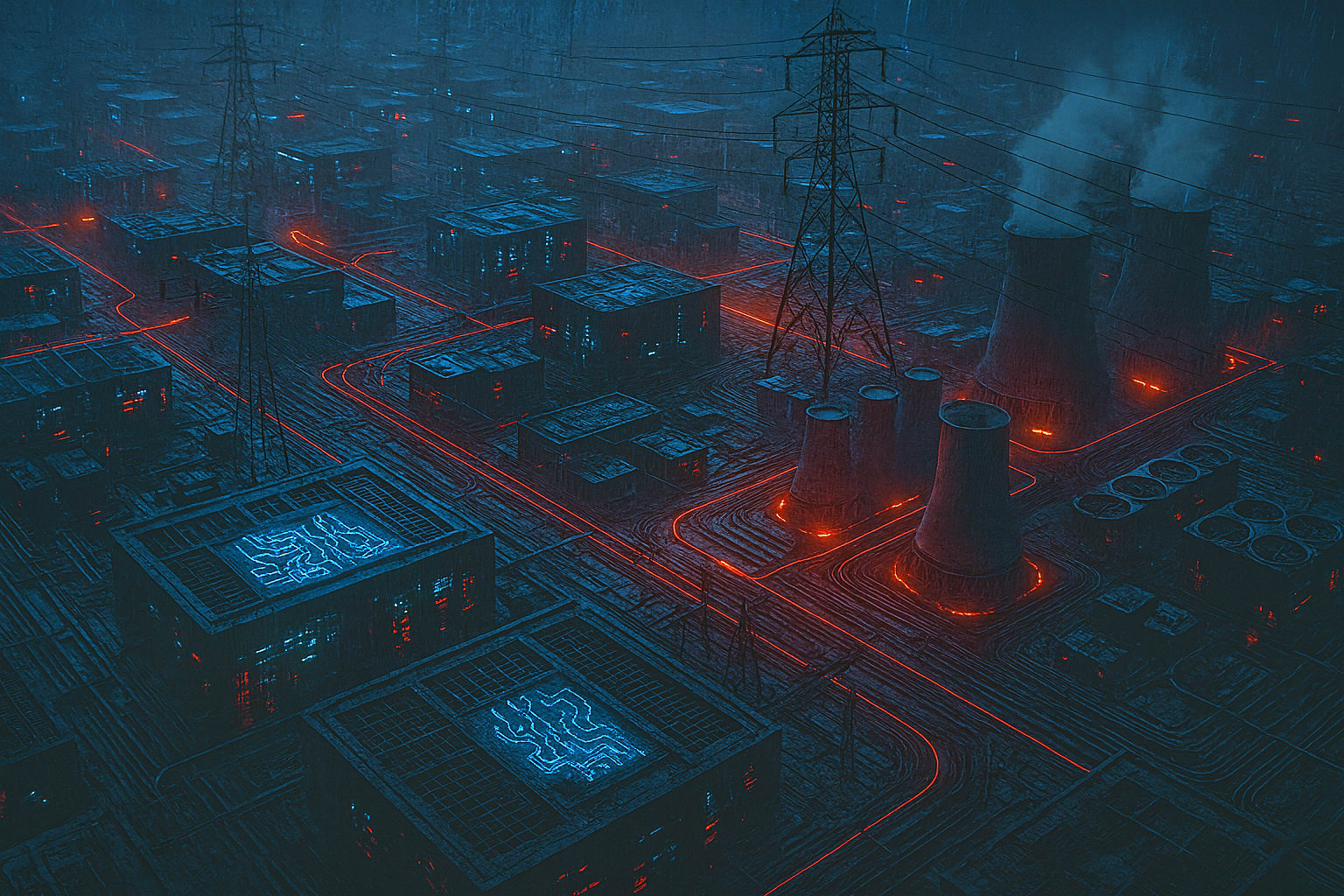
This is a cross-post from my Substack, East Wind
With Alphabet recently announcing that it would increase capital expenditures from $75B to $85B after blowout earnings and Meta’s Mark Zuckerberg promising to spend hundreds of billions of dollars in a bid to reach superintelligence, the contest to dominate the intelligence layer has narrowed to a handful of players, and at even greater levels of capital intensity.
In my last piece, I presented a framework for investing in foundation model companies with the potential to reach trillions in value. But there’s a more fundamental question: is there still enough air left in the room (capital and time) for a new challenger to emerge at the intelligence layer? On one side, tech incumbents are spending tens of billions of dollars per year on data centers. On the other, investors worldwide have poured over $100B collectively into AI labs, hoping to generate trillion-dollar outcomes. In this piece, I argue that the contenders at the foundation model layer are already set, and that no fresh pool of willing capital is likely to back another credible challenger.
In this post, I cover the following:
- How AI adoption is concentrating returns faster than any prior tech wave
- Why competing at the foundation layer is a capital game
- The competitive response of Big Tech (e.g. the Magnificent Seven)
- Why even well-funded labs now need to tap into the balance sheets of entire nations
- How China’s AI startups illustrate limits of innovation when faced with capital constraints
- In the world of accelerating returns, what are the implications for investors?
Let’s dive in.
AI companies are taking market share at the fastest pace in human history
Practitioners and investors who are in the AI “arena” by now are probably already accustomed to explosive growth of AI-native companies. I highlight several examples:
- OpenAI has become a $13B run-rate business less than 3 years after the release of ChatGPT and will likely close the year at $20B
- Anthropic is at nearly $5B in ARR and projects to end 2025 at $9B
- At the application layer, companies like Replit, Lovable and Cursor are all in the nine-figure run-rate territory (Cursor’s latest publicly disclosed run rate is over $500M)
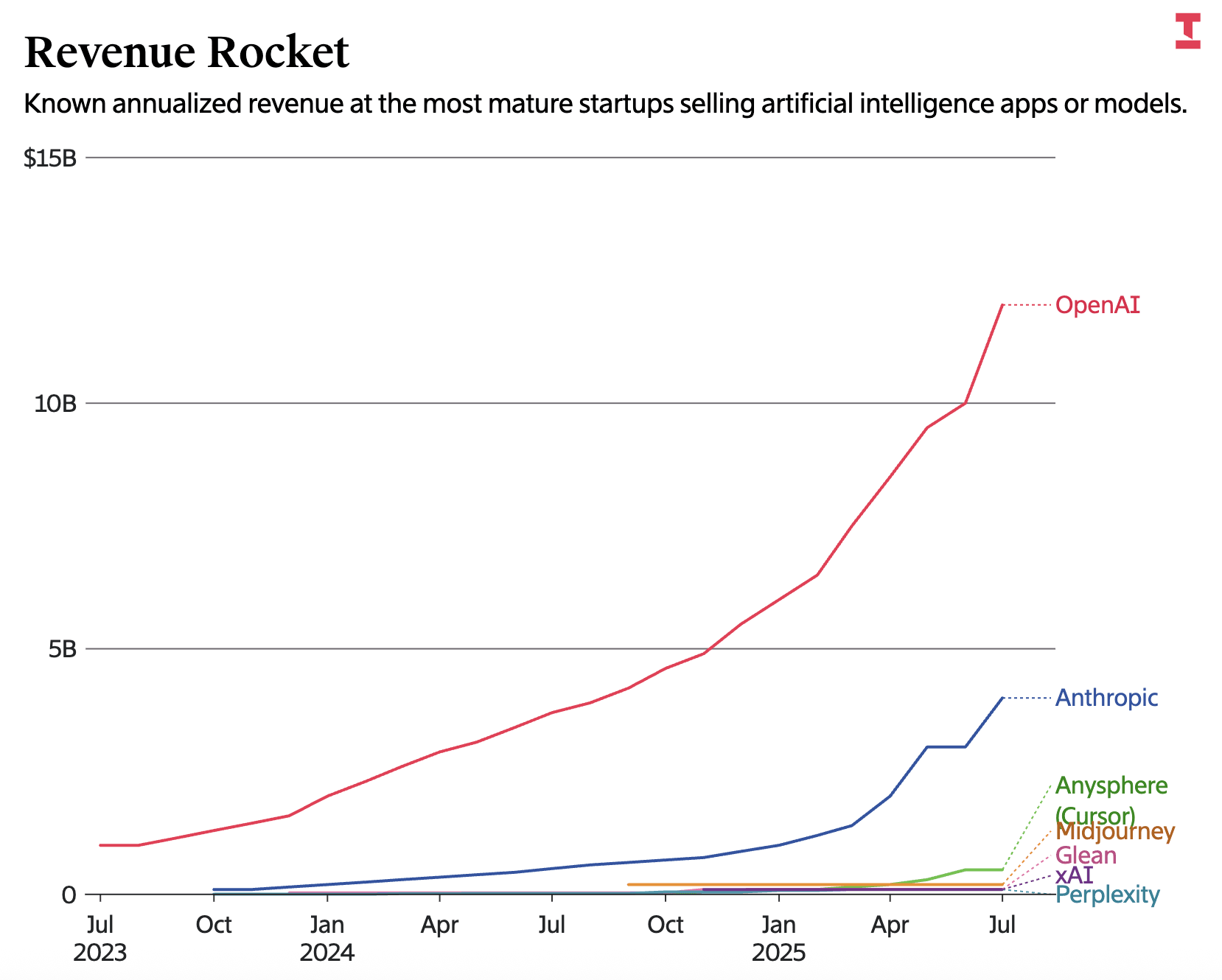
Source: The Information
While these growth rates seem shocking, they make complete sense when we apply the Ray Kurzweil “Law of Accelerating Returns”, which states that the rate of innovation has a tendency to accelerate over time as past innovations build on each other. I had Google Gemini pull some data on past technology cycles. Here, we see that each technology adoption cycle is significantly shorter than the preceding cycle (some cycles also overlap with each other).
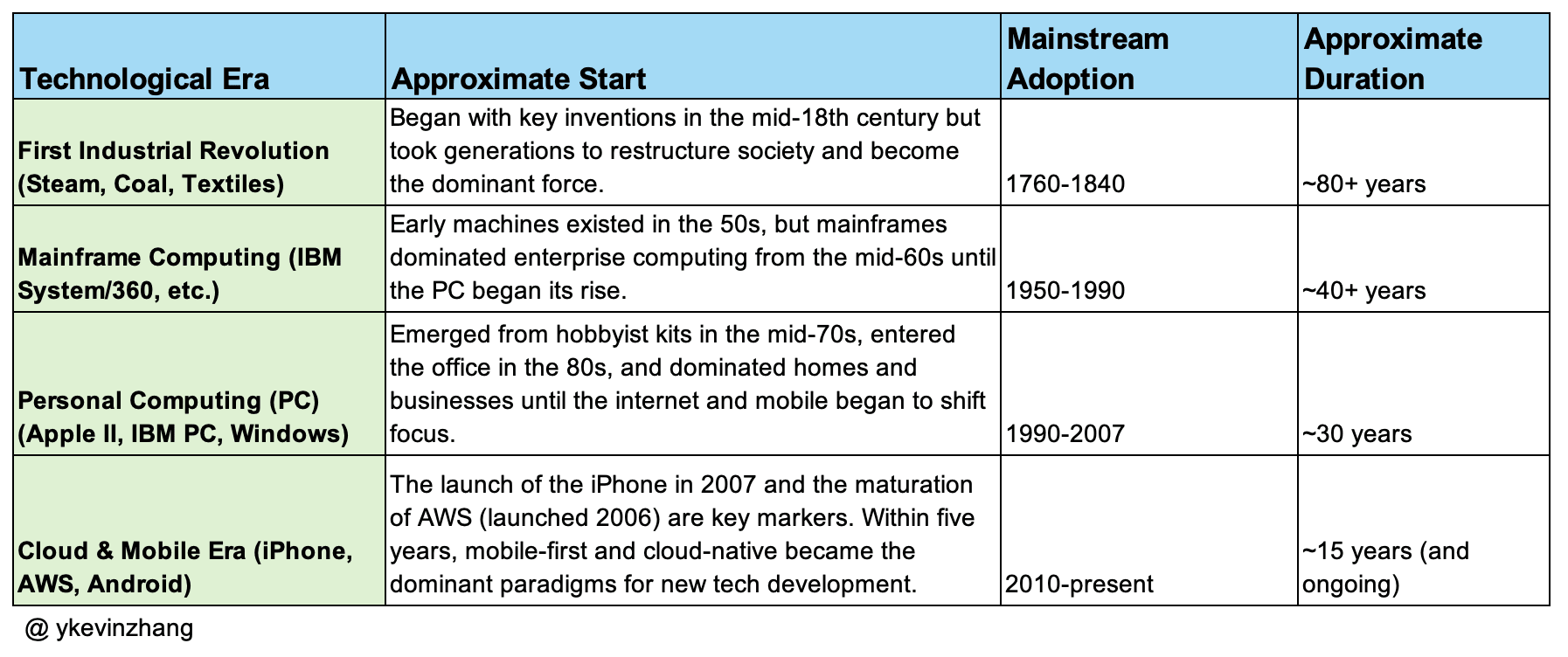
We might already be ~1/3 of the way through the AI era if ChatGPT is considered humanity’s “mainstream AI moment”, and the cycle lasts ~10 years (AlexNet or the Transformer paper arguably can also be considered the start of the AI era).
The more non-obvious takeaway is that the adoption of AI is also happening much faster than any other technology in history. It took Facebook ~four years to hit 100 million users. OpenAI’s ChatGPT, meanwhile, only took two months to hit the same number. Fast-forward to present day, Facebook’s MAU (monthly active users) is ~3.9B, while ChatGPT’s WAU (weekly active users) is over 700M, implying that its MAU is over 1B. This takeaway is supported by the Law of Accelerating Returns — if each cycle is roughly half the length of the previous one, then adoption is by definition accelerating. Now, if OpenAI continues to grow at this pace, then the human population is the only limiter. As ChatGPT becomes more sticky (e.g. memory), it’ll be harder for competing products like xAI’s Grok or Google’s Gemini win market share. This results in an extreme concentration of returns for winners. Now that we’ve established the velocity of AI adoption, the next question is: why is there such a need for capital?
Why is the foundation model layer a capital game?
To level-set the conversation, it’s important to contrast foundation model companies to traditional SaaS (software-as-a-service) companies. Traditional SaaS companies might have high R&D costs, but ongoing costs to serve software are comparatively minuscule. Foundation model companies, on the other hand, need to spend hundreds of millions of dollars (likely billions in the future), to train competitive models. Even after training a model, the marginal costs to serve AI models are material. This is especially true after OpenAI introduced its reasoning models in late 2024, where the models “think” before outputting an answer. This thinking process dramatically increases the cost to serve reasoning models relative to non-reasoning models. So, as long as we operate in a compute-constrained regime, capital matters.
As a result, startups like OpenAI, Anthropic, and xAI needed to raise tens of billions of dollars to build / lease data centers to train & serve their models. OpenAI and Anthropic were able to leverage their initial technology edge to establish distribution (via applications like ChatGPT). With that initial distribution, they’ve earned the right to raise tens of billions more to compete with tech incumbents. xAI, a recent entrant to the game, leveraged Elon’s personal net worth, a cadre of friendly venture firms, and interesting financial engineering to come up with the dollars needed to try to catch up. The rapid revenue growth of startups like OpenAI and Anthropic brings us to the next interesting dynamic — the competitive response from Big Tech.
Tech incumbents are aggressively reorienting themselves in the age of AI
Big Tech is no stranger to AI. Google invented the Transformer in 2017, Meta AI (formerly Facebook AI Research) was formed in 2013, and Nvidia’s GPUs were used to train AlexNet. But what Big Tech missed was the velocity that well-capitalized startups took market share. ChatGPT, for example, is now a credible threat to Google’s search advertising business (another reason for Google’s deflated market capitalization is due to its looming antitrust case decision). Meta, meanwhile, monetizes human attention. If AI chatbots start taking more of a user’s “digital attention”, then Meta risks getting disintermediated as well.
The initial response from big tech was sluggish (outside of investments into startups like OpenAI and Anthropic). Google’s Gemini launch was met with lukewarm reception, with concerns around performance and bias. But 2025 has become a very different year as Big Tech went all in on AI. The playbook these companies have adopted is to use their strong financial positions to catch up on technology (building competitive models), then leverage existing distribution to push product. Google has the most to show for so far, with some of the strongest text, image, and video models on the market. Its TPUs enable Google’s models to be served at scale, helping propel Gemini to hundreds of millions of monthly active users without needing to incinerate capital. We also see this from Big Tech’s capex:
- Alphabet / Google: $85B in 2025
- Microsoft: $30B this quarter (and over $100B over the next 12 months)
- Amazon: ~$100B
- Meta: $72B in 2025
Meta has gone a step further. Mark Zuckerberg is on a personal crusade to acquire top AI talent: “investing” in AI startups (Scale AI for $14B), poaching researchers for hundreds of millions of dollars, and even buying out venture funds. To understand the scale of capital being deployed, I pulled the tax revenues of the top seven countries by GDP alongside some high level stats for the Magnificent Seven.

As we can see — top companies in the Magnificent Seven are approaching the same revenue scale as the tax revenues of some of the wealthiest countries in the world! So, when a founder-CEO like Mark Zuckerberg decides to make a large bet in AI, that founder can essentially marshal the equivalent resources of a medium-sized country. Now, even these companies have seen their cash levels fall as capex approaches $100B per company annually (leading to the rise of private credit). This fundamentally changes the nature of risk capital — and I believe we’re just starting to see these dynamics play out, as I’ll highlight below.
Frontier AI labs and the capital arms race
When the AI wars first started in 2021/2022, investing in foundation model companies was relatively “affordable” (in the tens of millions or low hundreds of millions of dollars). There were a number of contenders from this era, including Anthropic, Adept, Inflection, and Cohere. Once the winners became more obvious (OpenAI / Anthropic) and models became more expensive to train, the capital required to compete at the frontier became extreme. Thinking Machines and Safe Superintelligence, the two new entrants to the game, each raised ~$2B within a year, and that may not be enough. The two front-runners, OpenAI and Anthropic, are raising $40B (across multiple tranches) and $5B, respectively.
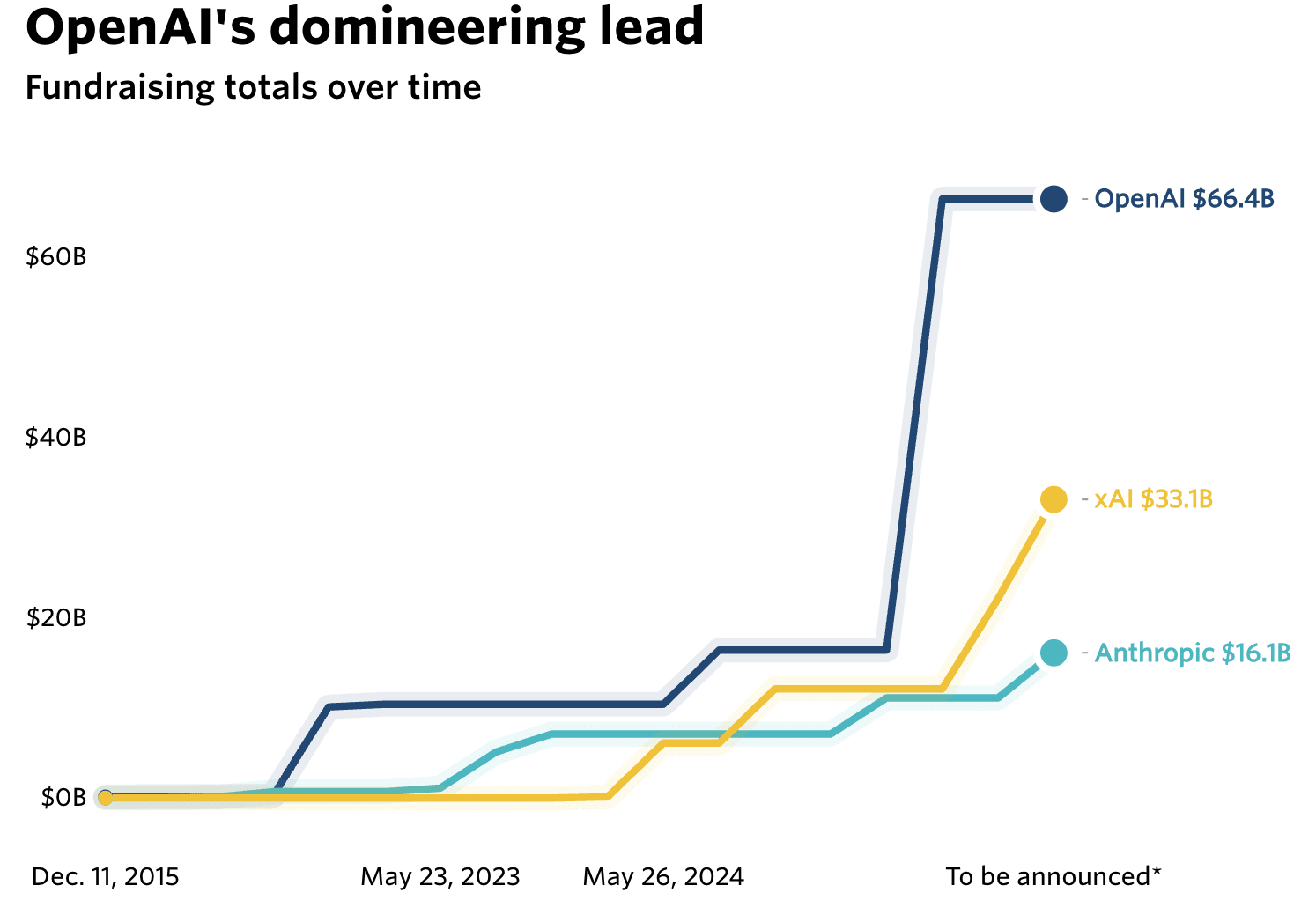
Source: PitchBook
This dynamic has started to distort the US venture capital ecosystem. In the first half of the year, over 1/3 of funding (~$70B) went to just 11 companies. In other words, capital has aggregated to perceived market winners (e.g. OpenAI / Anthropic / xAI) in a fashion that is even more concentrated than typical VC power-law dynamics. The result of this is all but the largest funds are priced out of investing at the foundation model layer. Looking at the chart above, top foundation model companies have already raised tens of billions to date to get to their current scale, and will need to raise tens of billions more to get to profitability:
- OpenAI needs to close another $20B+ as part of its last aforementioned $40B funding round
- Anthropic’s next funding round will probably be in the $5-10B range if its current fundraise is already $5B
- Mistral is currently in market to raise $1B from investors which include MGX, an investment firm backed by the Abu Dhabi government
The trend lines are becoming clear — in order to have the financial firepower to do battle with Big Tech, startups need to tap into the balance sheets of entire countries. Even Anthropic CEO, Dario Amodei, long wary of taking money from the Middle East, has concluded he needs to raise capital from Gulf States, stating that “if we want to stay on the frontier, we gain a very large benefit from having access to this capital. Without it, it is substantially harder to stay on the frontier.” Assuming American frontier AI labs maintain their ~1 generation lead, I see even more of the economic value accrue to these labs, and subsequently, more funding.
Now, a counterargument is that the profusion of open-source models (especially Chinese models), might entice enterprise users to leave a leading provider like Anthropic / OpenAI because those models might be more competitive from a performance / cost perspective. Having tested some of the leading Chinese models and products (e.g. DeepSeek, Doubao, K2, etc.), I’ve found that leading US models can accomplish some “jobs to be done” that weaker models simply cannot. Enterprises seem to agree, as the current focus has been on performance, not cost, when selecting API vendors, according to Menlo Ventures.
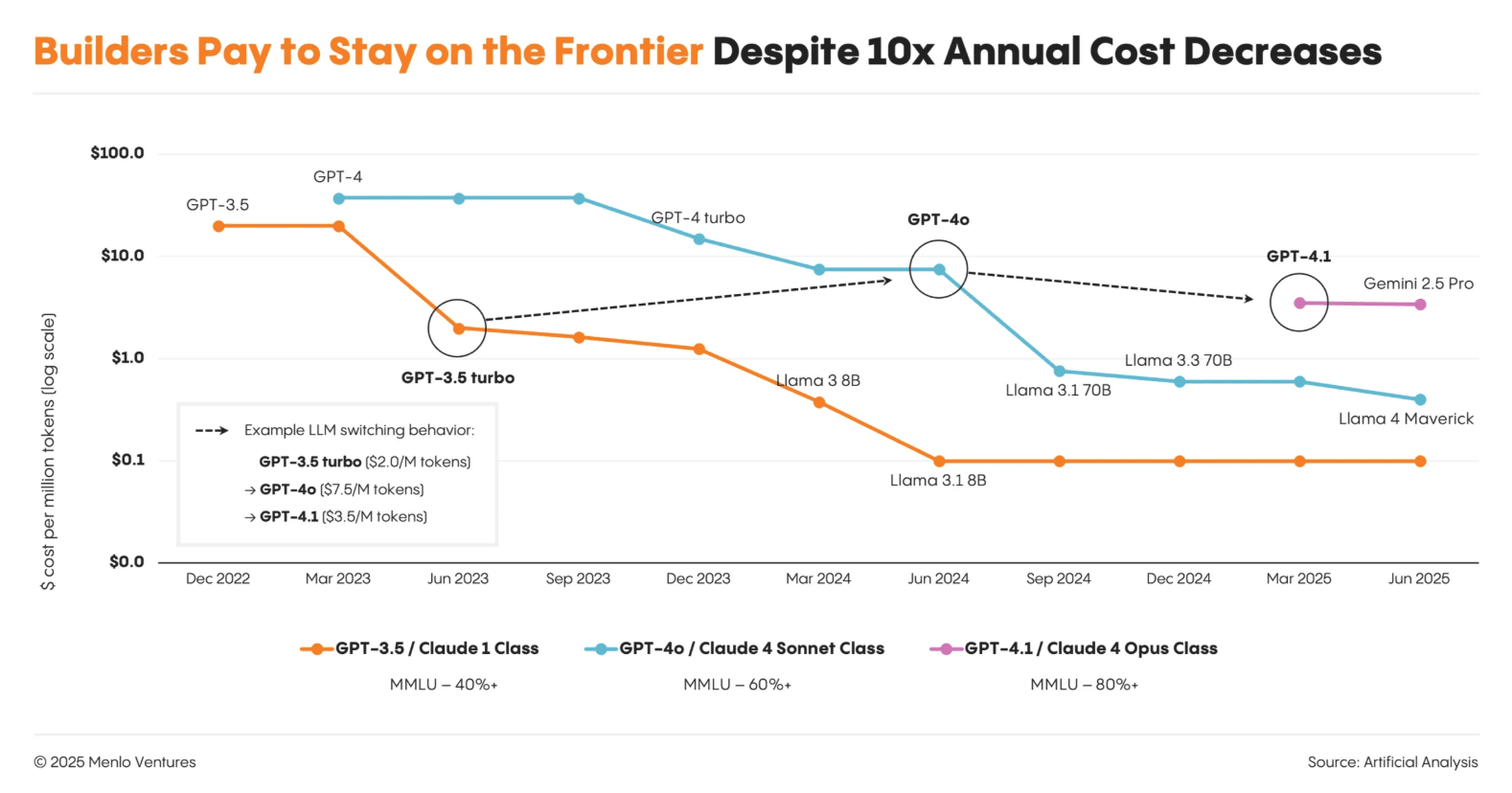
Source: Menlo Ventures
This dynamic creates a sort of reflexive loop:
- Strong model performance results in strong financial performance / traction
- …drawing investor interest & funding
- …allowing startups like OpenAI / Anthropic / xAI to use that funding to buy more GPUs / researchers
- …resulting in sustained frontier performance
The only thing that has challenged this cycle has been Big Tech tossing billions to hire the best researchers from AI labs. Regardless, I expect the game from now on to superintelligence to be a contest of capital, pitting global capital against Big Tech balance sheets.
What American investors get wrong about Chinese AI
What’s been very interesting, especially in light of the DeepSeek moment, is the state of AI development in China. Many investors now feel like they can’t “miss out” on China (the most vocal being former Benchmark Partner Bill Gurley). The sentiment is that Chinese open-source models have broadly caught up, using significantly less capital. Here, Gurley is incorrect (even if I do agree with him on the perils of tariffs). Chinese models score well on benchmarks, but falter in many real-world use cases relative to leading US models (the hesitance of Fortune 500 companies to use Chinese models is another factor). This will be the topic of a future post.
So, while China’s 六小虎 (Six Tigers) have raised significant capital (in the hundreds of millions / billion dollar scale), they trail US frontier labs mainly due to lack of funding / compute. To continue to be competitive, they need to raise capital at the $1B+ scale each for their next round. Given the state of the venture ecosystem in China, there isn’t enough risk capital to continue feeding these startups. I think this is why companies like Zhipu, Moonshot, and Minimax are rushing to IPO so they can use those proceeds to have another shot at capturing the frontier. Here, capital constraints don’t lead to innovation, but premature irrelevance.
Commercialization is another headwind: China’s SaaS adoption is low and consumer willingness to pay for AI is limited (e.g. ByteDance’s ChatGPT competitor, Doubao, is free). This is why current Chinese tech incumbents (Tencent, Alibaba, ByteDance, etc.) have monetized via e-commerce and advertising, and in Tencent’s case, gaming as well. AI startups have therefore focused on 出海 (go global). Unless there are structural changes, I anticipate existing tech giants (巨头) like Alibaba, Tencent, and ByteDance will win China’s domestic AI race.
Investing at the foundation model layer requires concentration
At the frontier, compute-scaled R&D makes capital the strategy, and for me, the “cone of uncertainty” has decreased substantially:
- A small number of startups have successfully used their initial technology edge to establish distribution (OpenAI, Anthropic), then raise capital
- Big Tech is using its capital advantage to catch up on model capabilities, then pushing its AI products via existing distribution
These companies’ strategies will likely converge: offering generalized personal and enterprise AI agents that billions of users can’t live without, monetizing via a combination of advertising and subscriptions. We see this already: ChatGPT added memory and app integrations (like Gmail) to become even more embedded in a user’s workflow. Anthropic’s Claude Code, meanwhile, lives within a user’s command-line interface (allowing it to access a user’s local file system), and can even be used for something like growth marketing.
I’ve also revised my priors — I believe the opportunity is much larger than my prior estimates. Even six months ago, it would have seemed far-fetched that engineers would pay $200/month for Claude Code. Since its launch, however, Claude Code has already reached $400M in ARR. I believe Claude Code is a leading indicator. In the future, white-collar workers will by necessity pay for the best AI tools, even if they cost hundreds of dollars per month, lest they become obsolete. This means that the enterprise copilot opportunity will be several hundred billion dollars a year (there are hundreds of millions of white-collar workers). Therefore, the outcomes for companies like OpenAI and Anthropic are easily in the trillions if they can sustain this pace of innovation. Smart money recognizes this too: betting on a tech incumbent (Google / Meta / Microsoft) might yield a 2-3x, whereas an OpenAI, Anthropic, or xAI, even at their current valuations, might still see a 10-20x return, which explains the immense, concentrated bets from global investors.
Now, there are several ways a new entrant can still win:
- If the Bitter Lesson is proven to be false (that computation beats specialized human domain expertise) and architectural improvements eviscerate OpenAI / Anthropic’s capital advantages
- New paradigms (e.g. Safe Superintelligence identifying a new mountain to climb) render the current transformer architecture obsolete
- Orthogonal technologies: while incumbents (Google, Tesla, Nvidia) and AI labs (OpenAI) are all exploring robotics, there hasn’t been a “ChatGPT moment” yet. An accelerated automation of labor will result in trillions of additional value being unlocked, though with the associated societal implications
These new competitors, however, will need to overcome the overwhelming capital and distribution advantages that current at-scale players have. The takeaway for institutional investors is that there will not be another trillion-dollar scale outcome at the foundation model layer, so the best way to “index” the market is to make concentrated investments in the top public / private companies.
There are also second-level effects of the Law of Accelerating Returns: as the pace and adoption of innovation accelerates, then theoretically companies will grow even faster (but this also means they get displaced even faster). What I think many investors are betting on, however, is that the competition at the foundation model layer operates under a different, more final assumption: that the race to superintelligence is the last game. If the first lab to reach this milestone can spur all subsequent innovation, it would create an insurmountable, permanent advantage. Therefore, the only strategy is to get there first, regardless of how much capital it takes.
Huge thanks to Will Lee, John Wu, Ying Chang, Yash Tulsani, Lisa Zhou, Maged Ahmed, Wai Wu, Chloe Lu, and Andrew Tan for the feedback on this article. If you want to chat about all things investing, ML/AI, and geopolitics, I’m around on LinkedIn and Twitter!